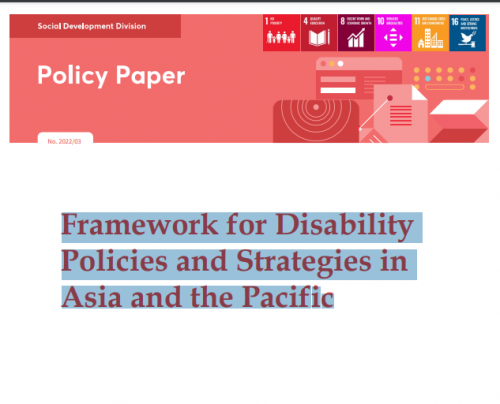
https://www.unescap.org/kp/2022/framework-disability-policies-and-strate...
https://www.unescap.org/sites/default/d8files/knowledge-products/Framewo...
EXECUTIVE SUMMARY
Since 1993, with the adoption of the first of three regional disability specific decades, the AsiaPacific region has been a leader in promoting disability-inclusive development. The Incheon Strategy to “Make the Right Real” for Persons with Disabilities (also known as the Incheon Strategy) was the first set of regionally agreed upon disability-specific development goals. The objective of this paper is to provide guidance to national governments on the role disability policies and strategies can play to ensure progress toward inclusive development and the realization of the Incheon Strategy goals and the broader Sustainable Development Goals (SDGs). The SDGs have recognized the need to leave no one behind. Yet without policies and strategies that focus explicitly on ways to promote inclusion, there is a real risk that persons with disabilities will be excluded from the benefits of national development plans and actions. There are, of course, some caveats. States have different legal and administrative systems and practices and have adopted different approaches toward ensuring compliance with international laws.
While it is both impossible to craft and not useful to implement a “onesize-fits-all” approach for national policies and strategies globally, this paper finds there are some shared broad elements that states may want to consider as they pursue their disabilityinclusive development agendas. This paper describes the functions of policies and strategies, bearing in mind the frame provided by international law, and in particular the Convention on the Rights of Persons with Disabilities (CRPD).
There are six main elements that can form the basis of national disability policies:
1) a commitment to mainstream disability in law and policy;
2) a vision that aligns the development agenda and CRPD;
3) a commitment of financial, technical support, and staff resources to achieve policy (and eventually strategic) objectives;
4) the establishment of mechanisms to facilitate implementation of laws and policies;
5) the setting of the government’s broad objectives vis-à-vis the inclusion of persons with disabilities;
and 6) the articulation of the assumptions and principles that guide implementation of the strategy.
Examples from around the globe illustrate the ways in which states have considered and incorporated these elements. The paper then presents four main elements that are found in different national disability strategies and presents examples from different states as illustrations. The four elements of disability strategies are: 1) a situational analysis and the identification of priorities 2) an articulation of a state’s general obligations, in other words, an overview of the investments it will make and the supports it will provide to facilitate non-discrimination, protection, autonomy and empowerment of persons with disabilities; 3) the specification of capacity building outcomes and objectives; and 4) the identification of measures to support the full inclusion of persons with disabilities in national development plans and programmes. Persons with disabilities all over the world experience discrimination and are more likely to be living in less favourable conditions, and with fewer opportunities and resources than their non-disabled peers. Many countries have shown, following their ratification of the CRPD and the adoption of the SDGs, a commitment to addressing inequalities and providing the support needed to facilitate full inclusion in the community. This paper aims to help governments to translate those commitments into action.










Add new comment